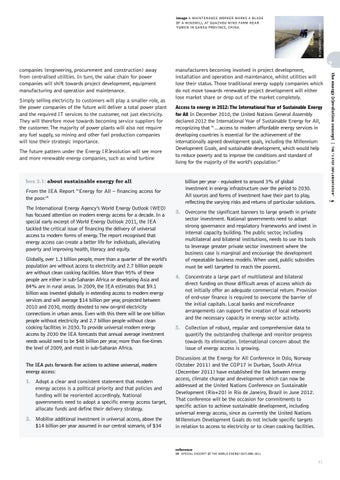© GP/MARKEL REDONDO
image A MAINTENANCE WORKER MARKS A BLADE OF A WINDMILL AT GUAZHOU WIND FARM NEAR YUMEN IN GANSU PROVINCE, CHINA.
2
Simply selling electricity to customers will play a smaller role, as the power companies of the future will deliver a total power plant and the required IT services to the customer, not just electricity. They will therefore move towards becoming service suppliers for the customer. The majority of power plants will also not require any fuel supply, so mining and other fuel production companies will lose their strategic importance.
box 2.1: about sustainable energy for all
From the IEA Report “Energy for All – financing access for the poor.19 The International Energy Agency’s World Energy Outlook (WEO) has focused attention on modern energy access for a decade. In a special early excerpt of World Energy Outlook 2011, the IEA tackled the critical issue of financing the delivery of universal access to modern forms of energy. The report recognised that energy access can create a better life for individuals, alleviating poverty and improving health, literacy and equity. Globally, over 1.3 billion people, more than a quarter of the world’s population are without access to electricity and 2.7 billion people are without clean cooking facilities. More than 95% of these people are either in sub‐Saharan Africa or developing Asia and 84% are in rural areas. In 2009, the IEA estimates that $9.1 billion was invested globally in extending access to modern energy services and will average $14 billion per year, projected between 2010 and 2030, mostly devoted to new on‐grid electricity connections in urban areas. Even with this there will be one billion people without electricity and 2.7 billion people without clean cooking facilities in 2030. To provide universal modern energy access by 2030 the IEA forecasts that annual average investment needs would need to be $48 billion per year, more than five‐times the level of 2009, and most in sub‐Saharan Africa. The IEA puts forwards five actions to achieve universal, modern energy access:
1. Adopt a clear and consistent statement that modern energy access is a political priority and that policies and funding will be reoriented accordingly. National governments need to adopt a specific energy access target, allocate funds and define their delivery strategy. 2. Mobilise additional investment in universal access, above the $14 billion per year assumed in our central scenario, of $34
Access to energy in 2012: The International Year of Sustainable Energy for All In December 2010, the United Nations General Assembly
declared 2012 the International Year of Sustainable Energy for All, recognizing that “…access to modern affordable energy services in developing countries is essential for the achievement of the internationally agreed development goals, including the Millennium Development Goals, and sustainable development, which would help to reduce poverty and to improve the conditions and standard of living for the majority of the world’s population.”
billion per year - equivalent to around 3% of global investment in energy infrastructure over the period to 2030. All sources and forms of investment have their part to play, reflecting the varying risks and returns of particular solutions. 3. Overcome the significant banners to large growth in private sector investment. National governments need to adopt strong governance and regulatory frameworks and invest in internal capacity building. The public sector, including multilateral and bilateral institutions, needs to use its tools to leverage greater private sector investment where the business case is marginal and encourage the development of repeatable business models. When used, public subsidies must be well targeted to reach the poorest. 4. Concentrate a large part of multilateral and bilateral direct funding on those difficult areas of access which do not initially offer an adequate commercial return. Provision of end‐user finance is required to overcome the barrier of the initial capitals. Local banks and microfinance arrangements can support the creation of local networks and the necessary capacity in energy sector activity. 5. Collection of robust, regular and comprehensive data to quantify the outstanding challenge and monitor progress towards its elimination. International concern about the issue of energy access is growing. Discussions at the Energy for All Conference in Oslo, Norway (October 2011) and the COP17 in Durban, South Africa (December 2011) have established the link between energy access, climate change and development which can now be addressed at the United Nations Conference on Sustainable Development (Rio+20) in Rio de Janeiro, Brazil in June 2012. That conference will be the occasion for commitments to specific action to achieve sustainable development, including universal energy access, since as currently the United Nations Millennium Development Goals do not include specific targets in relation to access to electricity or to clean cooking facilities.
reference 19 SPECIAL EXCERPT OF THE WORLD ENERGY OUTLOOK 2011.
31
THE “3 STEP IMPLEMENTATION”
The future pattern under the Energy [R]evolution will see more and more renewable energy companies, such as wind turbine
manufacturers becoming involved in project development, installation and operation and maintenance, whilst utilities will lose their status. Those traditional energy supply companies which do not move towards renewable project development will either lose market share or drop out of the market completely.
the energy [r]evolution concept |
companies (engineering, procurement and construction) away from centralised utilities. In turn, the value chain for power companies will shift towards project development, equipment manufacturing and operation and maintenance.
